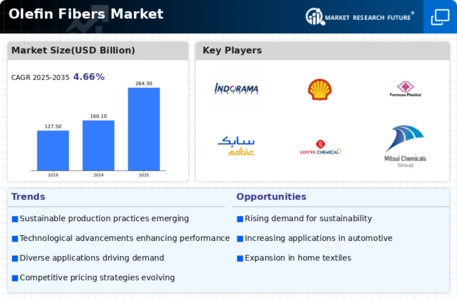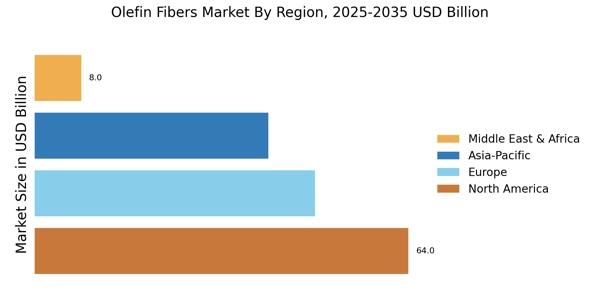Growing Outdoor Activities
The rise in outdoor activities is a notable driver for the Olefin Fibers Market. As more individuals engage in recreational activities such as hiking, camping, and sports, the demand for durable and lightweight materials has surged. Olefin fibers, with their excellent moisture-wicking properties and resistance to stains, are increasingly favored for outdoor apparel and gear. The market for outdoor textiles is projected to grow significantly, with olefin fibers playing a key role in this expansion. This trend is further supported by the increasing popularity of active lifestyles and the growing awareness of health and wellness. Consequently, the Olefin Fibers Market is poised to benefit from this shift, as manufacturers cater to the needs of outdoor enthusiasts seeking high-performance materials.
Sustainability Initiatives
The increasing emphasis on sustainability is a pivotal driver for the Olefin Fibers Market. As consumers become more environmentally conscious, there is a growing demand for eco-friendly materials. Olefin fibers, known for their recyclability and low environmental impact during production, align well with these sustainability goals. The market for olefin fibers is projected to grow at a compound annual growth rate of approximately 5% over the next few years, driven by the rising preference for sustainable textiles in various applications, including apparel and home furnishings. Manufacturers are increasingly adopting sustainable practices, which not only enhance their brand image but also cater to the evolving consumer preferences. This shift towards sustainability is likely to bolster the Olefin Fibers Market, as companies strive to meet the demand for greener alternatives.
Technological Advancements
Technological advancements play a crucial role in shaping the Olefin Fibers Market. Innovations in fiber production techniques, such as improved spinning and weaving technologies, have enhanced the quality and performance of olefin fibers. These advancements enable manufacturers to produce fibers that are lighter, stronger, and more durable, thereby expanding their applications in various sectors, including automotive, construction, and textiles. The introduction of smart textiles, which incorporate olefin fibers, is also gaining traction, as these materials offer functionalities such as moisture management and UV protection. The market is expected to witness a surge in demand for high-performance olefin fibers, driven by these technological innovations. As a result, the Olefin Fibers Market is likely to experience significant growth, as companies invest in research and development to stay competitive in this evolving landscape.
Expansion in Home Furnishings
The expansion in the home furnishings sector is a vital driver for the Olefin Fibers Market. As consumers increasingly invest in home decor and furnishings, the demand for versatile and durable materials has risen. Olefin fibers are particularly well-suited for applications such as carpets, rugs, and upholstery due to their stain resistance and ease of maintenance. The home furnishings market is projected to grow steadily, with olefin fibers playing a crucial role in meeting consumer demands for both aesthetics and functionality. Additionally, the trend towards outdoor living spaces has further fueled the demand for olefin-based textiles, as these materials are ideal for outdoor furniture and accessories. This expansion in home furnishings is likely to bolster the Olefin Fibers Market, as manufacturers capitalize on the growing interest in stylish and practical home solutions.
Rising Demand in Automotive Sector
The automotive sector is emerging as a significant driver for the Olefin Fibers Market. With the automotive industry increasingly focusing on lightweight materials to enhance fuel efficiency and reduce emissions, olefin fibers are gaining traction due to their lightweight and durable characteristics. These fibers are utilized in various automotive applications, including interior upholstery, carpets, and insulation materials. The demand for olefin fibers in the automotive sector is expected to grow as manufacturers seek to comply with stringent environmental regulations and consumer preferences for sustainable materials. This trend indicates a promising future for the Olefin Fibers Market, as the automotive sector continues to innovate and adopt advanced materials to improve vehicle performance and sustainability.


















Leave a Comment